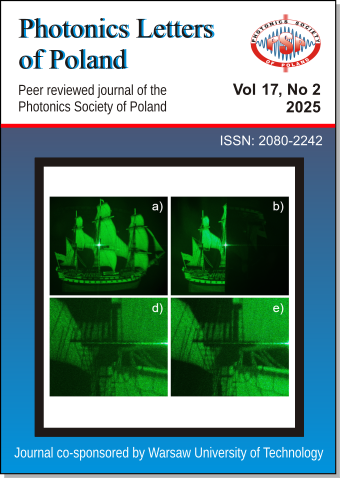Characterization of Kidney Stones type using Raman Spectrosco-py and Electron Microscopy
DOI:
https://doi.org/10.4302/plp.v17i2.1346Abstract
Raman spectroscopy (RS) is an excellent photonic measurement technique that can be extremely useful for characterizing kidney stones. Using RS, we can obtain precise information about the chemical composition and microstructure of the crystals that comprise kidney stones. Therefore, this non-invasive technique makes identifying different types of stones possible. Additionally, Raman spectroscopy supported by electron microscopy (SEM) imaging enables us to relate a given kind of crystal to its morphology. This paper presents the results of ex situ analysis of real samples of an unknown type of human kidney stone using RS and SEM techniques, which led to attempts to identify the stone.
Full Text: PDF
References
- P.J.S. Osther, Epidemiology of Kidney Stones in the European Union (Springer London, 2013). CrossRef
- G. Zeng, Z. Mai, S. Xia, Z. Wang, K. Zhang, L. Wang, Y. Long, J. Ma, Y. Li, S.P. Wan, W. Wu, Y. Liu, Z. Cui, Z. Zhao, J. Qin, T. Zeng, Y. Liu, X. Duan, X. Mai, Z. Yang, Z. Kong, T. Zhang, C. Cai, Y. Shao, Z. Yue, S. Li, J. Ding, S. Tang, Z. Ye, "Prevalence of kidney stones in China: an ultrasonography based cross-sectional study", BJU Int. 120(1), 109 (2017). CrossRef
- K. Christian, M. Johanna, A. Werner, B. Kathrin, G.M. Tesfay, R.H. Abbas A, W. Stefan, B. Andreas, N.F. Wilhelm, S. Florian, "Raman difference spectroscopy: a non-invasive method for identification of oral squamous cell carcinoma", Biomed Opt. Express 5(9), 3252 (2014). CrossRef
- C.A. Lieber, H.E. Nethercott, M.H. Kabeer, "Cancer field effects in normal tissues revealed by Raman spectroscopy", Biomed. Opt. Express 1(3), 975 (2010). CrossRef
- S. Feng, R. Chen, J. Lin, J. Pan, G. Chen, Y. Li, M. Cheng, Z. Huang, J. Chen, H. Zeng, "Nasopharyngeal cancer detection based on blood plasma surface-enhanced Raman spectroscopy and multivariate analysis", Biosens. Bioelectron. 25(11), 2414 (2010). CrossRef
- X. Cui, Z. Zhao, G. Zhang, S. Chen, Y. Zhao, J. Lu, "Analysis and classification of kidney stones based on Raman spectroscopy", Biomed. Opt. Express 9(9), 4175 (2018). CrossRef
- Y.-Ch. Hsu, Y.-H. Lin, L.-D. Shiau, "Effects of Various Inhibitors on the Nucleation of Calcium Oxalate in Synthetic Urine", Crystals 10, 333 (2020). CrossRef
- P. Chatterjee, A. Chakraborty, A. Mukherjee, "Phase composition and morphological characterization of human kidney stones using IR spectroscopy, scanning electron microscopy and X-ray Rietveld analysis", Spectrochimica Acta Part A: Molecular and Biomolecular Spectroscopy 200, 33 (2018). CrossRef
- W. Różański, Przegląd Urologiczny 6(58), 34 (2009). DirectLink
- C. Conti, L. Brambilla, C. Colombo, D. Dellasega, G. Diego Gatta, M. Realini, G. Zerbi, "Stability and transformation mechanism of weddellite nanocrystals studied by X-ray diffraction and infrared spectroscopy", Physical Chemistry Chemical Physics 43, 14560 (2010). CrossRef
- J. Duława, "Czynniki rozwoju kamicy nerkowej", Forum Nefrologiczne 3, 2, (2009). DirectLink
- J.W. Robinson, W.W. Roberts, A.J. Matzger, "Kidney stone growth through the lens of Raman mapping", Sci. Rep. 14, 10834 (2024). CrossRef
- E. Yakubovskaya, T. Zaliznyak, J. Martínez Martínez, et al., "Tear Down the Fluorescent Curtain: A New Fluorescence Suppression Method for Raman Microspectroscopic Analyses", Sci. Rep. 9, 15785 (2019). CrossRef
Downloads
Published
How to Cite
Issue
Section
License
Copyright (c) 2025 Michał Sładek, Marcin Procek, Sabina Drewniak, Piotr Kałużyński, Erwin Maciak

This work is licensed under a Creative Commons Attribution 4.0 International License.
Authors retain copyright and grant the journal right of first publication with the work simultaneously licensed under a Creative Commons Attribution License that allows others to share the work with an acknowledgement of the work's authorship and initial publication in this journal. Authors are able to enter into separate, additional contractual arrangements for the non-exclusive distribution of the journal's published version of the work (e.g., post it to an institutional repository or publish it in a book), with an acknowledgement of its initial publication in this journal. Authors are permitted and encouraged to post their work online (e.g., in institutional repositories or on their website) prior to and during the submission process, as it can lead to productive exchanges, as well as earlier and greater citation of published work (See The Effect of Open Access).




